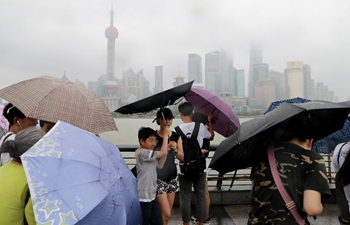BEIJING, Aug. 18 (Xinhua) -- On Sept. 22, 1985, the United States, during Ronald Reagan's presidency, signed the Plaza Accord with France, former West Germany, Japan and Britain at the Plaza Hotel in New York City.
The agreement was aimed at coping with the over-valuation of the U.S. dollar against currencies of other major economies and the continuous rise of the U.S. trade deficits.
However, it was later proven that intervening in exchange rates failed to achieve a trade balance. The rates were just a scapegoat.
Moreover, Japan was seriously hurt by its improper response. The East Asian country's strong economic growth ended abruptly at the start of the 1990s, followed by a period of economic stagnation known as the Lost Decade.
PLAZA ACCORD
The U.S. dollar continued to rise in the early 1980s. As a result, trade deficits of the United States kept growing.
The U.S. inflation rates were as high as 13 percent in 1979 and the U.S. economy was pulled into recession twice between 1980 and 1982.
To end the downward spiral of the economy, Paul Volcker, then chairman of the Federal Reserve, raised interest rates to curb inflation. However, the move led to a rise in both the exchange rates and the trade deficits.
From 1980 to 1985, the overall appreciation of the U.S. dollar against the Japanese yen, Deutsche mark, French franc and British pound reached around 50 percent, according to the Organization for Economic Cooperation and Development, putting considerable pressure on U.S. exports.
At the same time, Japan's fast-growing, export-oriented economy has further brought up the U.S. deficits. The United States was able to achieve a current account surplus in 1980 but by 1985, its current account deficits accounted for 2.71 percent of the gross domestic product (GDP).
It was against the aforementioned background that the signing of the Plaza Accord occurred. Though France, former West Germany and Britain made concessions, Japan was the one that compromised the most.
According to the agreement, Japan should further open up its domestic market for foreign goods and services, loosen private sector supervision to boost vitality, adopt a monetary policy that allows more flexibility in the exchange rates of the yen, and make its financial market more open.
Furthermore, Tokyo was also asked to reduce government deficits and create conditions conducive to private sector growth, as well as boost domestic consumption and encourage mortgage loans.
Among the six measures, the appreciation of the yen against the U.S. dollar was the core goal.
In the short run, measures agreed by the Plaza Accord effectively curbed the overvaluation of the dollar and shaved off the deficits. In 1991, U.S. trade returned to a surplus.
However, as economic globalization accelerated in 1995, the country was again confronted with challenges in its foreign trade.
The root cause for the protracted U.S. trade deficit was the structural problem that the investment rate exceeds the savings rate. As Stephen Roach, a former Morgan Stanley Asia chairman, told CNBC in March at the annual China Development Forum, the deficits fundamentally reflect "the fact that we don't save enough."
Nevertheless, for political reasons, both the business community and politicians in the United States tend to pick scapegoats for trade imbalance.
In the early 1980s, American agricultural and industrial exporters began to lobby Congress, and the strong protectionist sentiment was the direct driving force behind the Plaza Accord.
It is thus clear that exchange rates and international trade are not only an economic issue, but also a political one.
EFFECTS AND DEBATES
Why did Japan fall victim to an economic meltdown out of all five signatories? A lesson might be drawn here for the Japanese government.
An immediate effect of the accord was a much stronger yen, which experienced a 50 percent hike against the dollar between 1985 and 1987. Nonetheless, the appreciation didn't cause a significant fluctuation in the financial market as the Japanese economy maintained fast growth until 1990.
Meanwhile, however, the Japanese government went for a credit expansion to secure its economic competitiveness against an excessive appreciation of the yen. It did so by lowering its benchmark interest rates from 5 percent to 2.5 percent, a move which created bubbles in the stock and property markets.
Plagued by an overheated economy, the government resorted to rate hikes in 1989, radically lifting benchmark interest rates to 6 percent in just over a year. Intense monetary stringency turned boom into bust, sending the Japanese economy into a "Lost Decade."
Bank of Japan Governor Haruhiko Kuroda pointed out in 2004 that the hyperinflation and asset bubble boiled down to more of "a policy failure" than "an appreciated yen."
Today, debates are still going on over how exactly the accord was related to the ensuing economic crisis.
LESSONS TO LEARN
Notably, Japan had basically achieved post-war economic recovery despite a prolonged economic downturn since the economic bubble burst in 1990. With a nominal per capita GDP of 28,700 U.S. dollars -- higher than the 24,400-dollar level in the United States -- Japan ranked among the most developed countries.
The private sector was actively seeking a way out. First, with a rising yen, the government sought to expand outbound investment and transfer production capacity overseas to offset U.S. trade protectionism.
For example, automaker Toyota has accumulatively invested 22 billion dollars and employed 136,000 people in the United States as part of an effort to resolve the long-standing bilateral dispute, setting an example of how localized production helps mitigate risks of trade war and enhance brand awareness overseas.
Second, yen appreciation and trade friction drove up corporate upgrading and technological innovation, transforming Japan's manufacturing sector to one marked by high-end and high value-added products. In the meantime, companies worldwide were learning from Japan to reduce costs and raise efficiency.
As a result, Japan's private sector has emerged increasingly competitive in the global arena despite domestic economic stagnation, with Japanese-made cars and portable players becoming a trendy fashion at the turn of the century.
Japanese companies profit not by expanding market shares with lower prices, but by managing sales and putting more emphasis on high quality and low cost, Kiyoyuki Seguchi, director of the Canon Institute for Global Studies, told Xinhua.

















